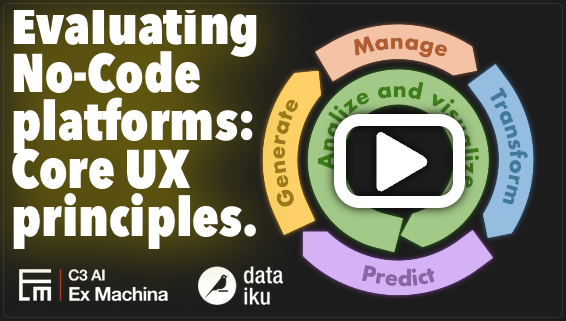The Hello World of data: load a CSV to get a feel for the core UX | Sharing the data workflow
Any solution to a productivity problem must address both organizational and cognitive rationality. I start my review journey into data platforms by loading a CSV to C3.ai Ex Machina and Dataiku DSS to understand how they leverage UX to meaningfully represent the data workflow.

Dealing with data and related processing and analysis is a very complex cognitive activity. Platforms that provide solutions related to data and AI, project images and dreams of beautiful graphs, smart data, powerful processing, cloud simplicity and so on, all important outcomes of any such platform to be sure.
But where do they stand on the user experience of the data workflow itself?
When dealing with improving the productivity of any value-production context, there are two main levers:
- the organizational rationality: are your teams and organizations set up in order to minimize the number of steps required to generate value? How to remove sociological and political silos that generate arbitrary work requirements?
- the cognitive rationality: how much cognitive load are the tools putting on people that use them? How to improve the speed, reliability and number of required actions of the individual tasks performed by people?
Any solution to a productivity problem must address both of these productivity components, in order to have a notable impact on Net Working Capital requirements of the business under transformation.
For now, we'll focus on the second, the cognitive load reduction of platform users. In this initial platform review video, I look at the first two platforms in my review portfolio: C3.ai's Ex Machina and Dataiku Data Science Studio. I introduce the datasets that I am using in my review, then start with the Hello World task of data processing: loading a CSV and viewing the data table.
This gives me a simple task with which I can expose the core data workflow UX paradigm of each platform. I discuss the pros and cons of each.
Do you have experience in No-/Low-code data and AI platforms? Do you have a different view of the Dataiku or Ex Machina core UX paradigm that you would like to share?
In subsequent videos, we will look in detail at each type of data process such as pivots, joins, cleanup and enrichment tasks, visualization and so on, but in the next one I'll introduce a couple more platforms, among Sagemaker, GoodData, S3 and Quicksight. They do different things, but they all require you to load data somewhere. We'll look at how they do that and how they represent data workflows.
You can subscribe below to receive these updates as a newsletter and comment on this platform. If you prefer to engage on LinkedIn, that's fine too.

Comments